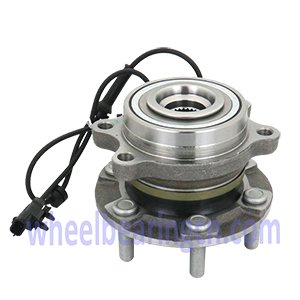How do wheel hubs work: All about a wheel hub assembly.
From making a safe turn on a winding country road to changing lanes on the highway, you rely on your vehicle to steer with precision every time you get behind the wheel. Have you ever wondered what allows you to turn left or right, or even go straight down the road? You might be surprised to learn that the small parts called wheel hubs assembly are key components of the steering system.

What is a wheel hub assembly?
The wheel hub assembly, which is responsible for mounting the wheel to the vehicle, is a pre-assembled unit containing precision bearings, seals and sensors. Also known as wheel bearings, wheel assemblies, wheel units or wheel bearing assemblies, wheel hub assemblies are critical components of the steering system that help ensure safe steering and handling of the vehicle.
Where is it located?
On each wheel, you will find the hub assembly located between the drive shaft and the brake drum or disc. On the disc side, the wheel is bolted to the studs of the hub assembly. On the driveshaft side, on the other hand, the wheel hubs are mounted to the steering knuckle as a bolt-on or press-fit assembly.
To view the hub assembly, you will need to remove the wheel and then remove the caliper and brake rotor.
In most newer vehicles built after 1998, there is a hub assembly for each wheel. When the assembly is damaged, it needs to be removed and replaced with a new one. In vehicles built before 1997, front-wheel drive vehicles use a hub assembly on each wheel, while rear-wheel drive vehicles use two separate bearings and seals on the two front wheels. Unlike the hub assembly, the bearings can be repaired.
What does a wheel hub assembly do?
First and foremost, hub assemblies secure the wheels to the vehicle, allowing them to turn freely so you can drive safely.
The hub assembly is also critical to the Anti-lock Braking System (ABS) and Traction Control System (TCS). In addition to the bearings, the hub assembly contains the wheel speed sensor that controls the vehicle’s ABS braking system. This sensor continuously communicates the rotation speed of each wheel to the ABS control system. In an emergency braking situation, the system uses this information to determine if anti-lock braking is required.
The vehicle’s traction control system also uses the ABS wheel sensors for operation. As an extension of the antilock braking system, the TCS system works in conjunction with the ABS system to help you control your vehicle. If this sensor malfunctions, it could damage both the antilock braking system and the traction control system.
How do I know if I have a bad wheel hub assembly?
A malfunctioning wheel assembly can cause a variety of symptoms, including:
- Growling, buzzing, squealing, squeaking or screeching tires while driving at 30-45 mph.
- The steering wheel may shake while driving.
- The ABS indicator light will come on if there is an abnormal sensor reading or loss of signal.
What can happen if I drive with a damaged wheel hub assembly?
Driving a vehicle with a damaged wheel assembly is very dangerous. As the bearings inside the assembly wear out, they can cause the wheels to not turn smoothly. Your vehicle may become wobbly and the wheels may tend to come loose. Additionally, if the wheel hub assembly deteriorates, the steel may break, causing the wheel to fall off.
If you suspect a faulty wheel assembly, take your vehicle to a mechanic you trust for repairs. Learn more about quality wheel hub assembly parts, find your auto parts, or find out where to buy auto parts today.
